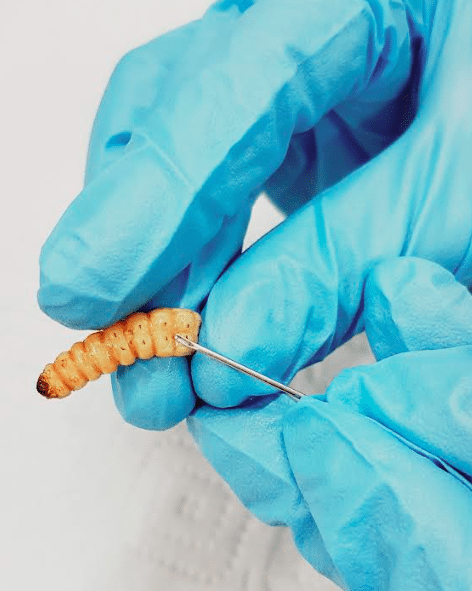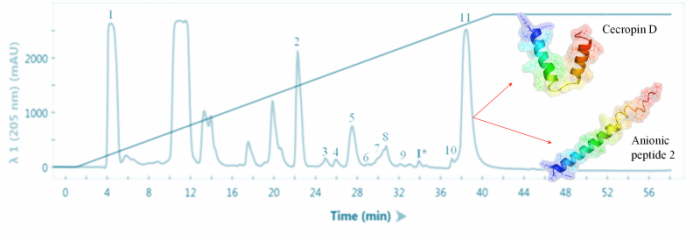
Leishmaniasis is a very serious group of diseases, and are caused by more than 20 species of protozoan parasites belonging to the genus of Leishmania. Epidemiological surveillance reveals that more than 350 million people in 98 countries are at potential risk of infection, which makes Leishmaniasis one of the six endemic diseases considered as high priorities worldwide [1].
One of the main clinical manifestations in humans is cutaneous leishmaniasis affecting the skin, which eventually causes disfiguring scars [2]. World Health Organization recommendations for cutaneous treatment rely primarily on chemotherapeutic agents like sodium stibogluconate, meglumine antimoniate, and Amphotericin B. Unfortunately, the use of these treatments is commonly associated with severe adverse reactions [3].
Based on this reality, researchers from the University of Antioquia have centered their attention on the evaluation of antimicrobial peptides (AMPs) as potential anti-leishmanial drugs. AMPs are part of the chemical defense system of most organisms; they play a very important role in the non-specific response against pathogen invasion [4]. These molecules have been isolated from bacteria, fungi, plants, and animals, showing a broad spectrum of antimicrobial activity. One of the most promising characteristics of AMPs is the membrane disturbing mechanism of action whereby they exert the biological activity.
In a recent paper published in Analytical Biochemistry, researchers from the University of Antioquia explain how they used the Galleria mellonella (G. mellonella) moth as a biological model to induce a differential expression of AMPs. The greater wax moth G. mellonella has been successfully used as a biological model to study the insect immune response [5]. Different studies of this insect revealed a different response depending on the kind of challenge. AMPs are synthesized into fat body and hemocytes of insects and they are secreted into hemolymph as part of the systemic response against pathogens.

Fig 2. Process for innoculating the larvae with Leishmania parasites. (Credit: Marcela Manrique-Moreno)
In the research, larvae were infected with Leishmania (Viannia) panamensis promastigotes and the immunological response of the larvae was followed by using analytical techniques like electrophoresis and chromatography. The main goal of the research was to identify peptides that larvae produce as a chemical armory to fight the parasite infection. Hemolymph samples from the insects were collected and processed to obtain the low molecular weight proteins. Samples from larvae non-infected and infected were collected to compare.
The processed hemolymph samples were fractionated by reverse-phase HPLC and each fraction was evaluated against Leishmania in vitro cultures. The most active fractions against parasites were compared with the control fractions (non-infected samples) to identify by 2D-electrophoresis the differential peptides produced by the larvae due to the infection. Using mass spectrometry, two peptides were identified in the active fraction: a fragment from the Anionic peptide 2 and Cecropin-D. Both peptides were synthesized and evaluated against Leishmania in vitro cultures with promising antiparasitic activity.

Fig 3. HPLC low molecular weight profile of the hemolymph obtained after the inoculation of Leishmania parasites. (Credit: Marcela Manrique-Moreno)
These findings are described in the article entitled Identification and Evaluation of Galleria mellonella Peptides with Antileishmanial Activity, recently published in the journal Analytical Biochemistry. This work was led by Isabel A. Patiño-Márquez, Edwin Patiño-González, Laura Hernández-Villa, Blanca Ortíz-Reyes and Marcela Manrique-Moreno from the University of Antioquia.
References
- D. Pace, Leishmaniasis, J. Infect., 69 Suppl 1 (2014) S10-18.
- R. Reithinger, J.-C. Dujardin, H. Louzir, C. Pirmez, B. Alexander, S. Brooker, Cutaneous leishmaniasis, Lancet Infect. Dis., 7 (2007) 581-596.
- J. Blum, P. Desjeux, E. Schwartz, B. Beck, C. Hatz, Treatment of cutaneous leishmaniasis among travellers, J. Antimicrob. Chemother., 53 (2004) 158-166.
- K.A. Brogden, M. Ackermann, P.B. McCray, B.F. Tack, Antimicrobial peptides in animals and their role in host defences., Int. J. Antimicrob. Agents, 22 (2003) 465-478.
- N. Ramarao, C. Nielsen-Leroux, D. Lereclus, The insect Galleria mellonella as a powerful infection model to investigate bacterial pathogenesis, Journal of visualized experiments: JoVE, (2012).









